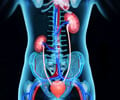A risk score calculation that can help predict which patients with rhabdomyolysis may be at risk for the severe complication of kidney failure or death was developed by researchers.

"Currently doctors cannot easily predict which patients are most likely to have severe kidney failure or die from rhabdomyolysis," explained Gearoid McMahon, MB, BCh, a clinical fellow in BWH’s Department of Medicine and lead author on this study. "Using routinely available clinical variables, we have developed a new risk prediction score that doctors can use to help predict a patient’s expected outcome and plan for treatment accordingly."
The researchers conducted a retrospective cohort study of 2,371 patients admitted between 2000 and 2011 and analyzed variables that are thought to be associated with poor outcomes in this patient population, such as age, gender, and CPK levels. Using data from this analysis, researchers created a risk prediction score based on the variables that were most significantly associated with poor outcomes. The final variables that were included in the created model were age, gender, levels of initial phosphate, calcium, creatinine and CO2, CPK, and cause of rhabdomyolysis.
"This model may be particularly useful to evaluate and triage patients in the Emergency Department (ED)," said Sushrut Waikar, MD, MPH, director of Renal and Ambulatory Services at BWH and senior author of the study. "By current practice standards, patients with rhabdomyolysis are treated similarly regardless of the underlying cause and overall risk profile. Knowledge of the predicted risk of adverse outcomes may lead clinicians to choose different treatment options such as intravenous fluid administration in the ED followed by discharge with plans for repeat outpatient labs, rather than inpatient hospitalization for observation."
The researchers note that the next step will be to validate this risk score in other populations and to test its ability to guide treatment decisions. An online version of the Brigham rhabdomyolysis risk score is available at: http://www.brighamandwomens.org/research/rhabdo/default.aspx.
This research is consistent with the recent trend in medicine toward patient-centered outcomes research (PCOR), which focuses on identifying the risk of each patient and tailoring the treatment to improve their individual outcomes. BWH recently established the Patient-centered Comparative Effectiveness Research Center (PCERC) for researchers, like McMahon, that are dedicated to improving the health outcomes of BWH patients.
Advertisement













